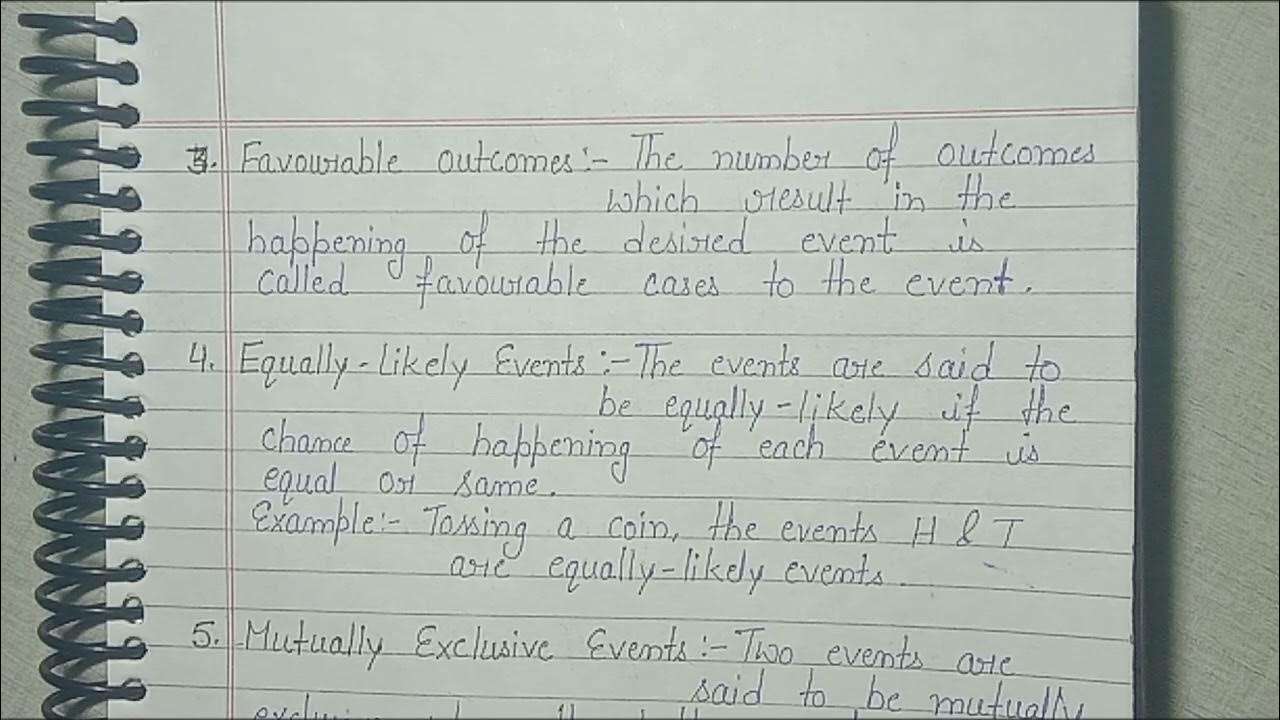Axioms of Probability - Probability and Statistics | Engineering Mathematics | GATE CSE
Summary
TLDRThis session explores the fundamentals of probability, discussing the probability of events being greater than zero but less than one, the certainty of sample spaces at 100%, the addition rule for non-mutually exclusive events, and the multiplication rule for dependent events. It also covers conditional probability, changing the sample space based on conditions, and the concept of independent events where probabilities multiply directly.
Takeaways
- 😀 The probability of an event E in a sample space S ranges from greater than or equal to zero to less than or equal to one, and in percentage terms, it's between 0% to 100%.
- 📚 The probability of the entire sample space is always one or 100%, as it represents all possible outcomes.
- 🔍 For any two events A and B, the probability of their intersection can be calculated using the formula P(A ∩ B) = P(A) + P(B) - P(A ∩ B).
- 🔄 If events A and B are mutually exclusive, their intersection probability P(A ∩ B) becomes zero, and the union probability is simply the sum of their individual probabilities P(A ∪ B) = P(A) + P(B).
- 🤔 The multiplication rule states that the probability of the intersection of events A and B is P(A ∩ B) = P(A) * P(B | A) or P(A) * P(B given A), provided P(A) ≠ 0 and P(B) ≠ 0.
- 🎲 Conditional probability changes the sample space, focusing on the outcomes where a certain condition has already occurred, such as the probability of rolling a 3 given that the roll is an odd number.
- 🚫 If events A and B are independent, the probability of their intersection is simply the product of their individual probabilities, P(A ∩ B) = P(A) * P(B).
- 🔗 The concept of conditional probability is crucial in understanding how the probability of one event changes given the occurrence of another event.
- 📉 The sample space can be reduced in conditional probability scenarios, as seen in the example where the sample space is reduced to odd numbers when calculating the probability of rolling a 3 given that the roll is odd.
- 🔄 For multiple independent events, the probability of their intersection is the product of their individual probabilities, extending the rule for two events to any number of events.
Q & A
What is the range of probability values for an event E in the sample space S?
-The probability of an event E is greater than or equal to 0 and less than or equal to 1, which can also be expressed as between 0% to 100%.
Why is the probability of the sample space always 100%?
-The sample space represents all possible outcomes of an experiment, ensuring at least one outcome will definitely occur, thus covering the entire space and making its probability 100%.
How is the probability of the intersection of two events A and B calculated?
-The probability of the intersection of A and B is given by the sum of the probabilities of A and B minus the probability of their intersection, i.e., P(A ∩ B) = P(A) + P(B) - P(A ∩ B).
What happens to the probability of the intersection of two mutually exclusive events A and B?
-If events A and B are mutually exclusive, there is nothing in common between them, making the probability of their intersection zero, P(A ∩ B) = 0.
How does the probability of the union of mutually exclusive events differ from non-mutually exclusive events?
-For mutually exclusive events, the probability of their union is the sum of their individual probabilities, P(A ∪ B) = P(A) + P(B), as there is no overlap.
What is the multiplication rule for the probability of two events A and B?
-The multiplication rule states that the probability of the intersection of A and B is the product of the probability of A and the probability of B given that A has occurred, or vice versa, P(A ∩ B) = P(A) * P(B|A) or P(A ∩ B) = P(B) * P(A|B), provided P(A) ≠ 0 and P(B) ≠ 0.
What is the difference between joint probability and marginal probability?
-Joint probability refers to the probability of two events occurring together, like P(A ∩ B). Marginal probability refers to the probability of a single event occurring, such as P(A) or P(B), without considering the other event.
How does conditional probability change the sample space?
-Conditional probability, such as P(A|B), changes the sample space by considering only those outcomes where the condition (B has occurred) is met, effectively reducing the sample space to only those outcomes that satisfy the condition.
Can you provide an example of conditional probability from the script?
-An example given in the script is the probability of rolling a 3 given that the roll is an odd number. The new sample space is reduced to the odd numbers {1, 3, 5}, making the probability of rolling a 3 1/3.
What is the relationship between the probability of two independent events and their intersection?
-For independent events A and B, the probability of their intersection is the product of their individual probabilities, P(A ∩ B) = P(A) * P(B), as the occurrence of one event does not affect the other.
How does the probability of the intersection of multiple independent events extend the rule for two events?
-For n independent events, the probability of their intersection is the product of their individual probabilities, P(E1 ∩ E2 ∩ ... ∩ En) = P(E1) * P(E2) * ... * P(En), without any additional requirements.
Outlines

This section is available to paid users only. Please upgrade to access this part.
Upgrade NowMindmap

This section is available to paid users only. Please upgrade to access this part.
Upgrade NowKeywords

This section is available to paid users only. Please upgrade to access this part.
Upgrade NowHighlights

This section is available to paid users only. Please upgrade to access this part.
Upgrade NowTranscripts

This section is available to paid users only. Please upgrade to access this part.
Upgrade NowBrowse More Related Video

Probability Part 1: Rules and Patterns: Crash Course Statistics #13

Addition Rule of Probability - Explained

Kaidah Pencacahan (Bab Peluang) Matematika SMK Kelas X

PELUANG KEJADIAN SALING LEPAS DAN TIDAK SALING LEPAS

Probability, Meaning and basic concepts of Probability

Peluang Kejadian Majemuk (Peluang Saling Lepas dan Tidak Saling Lepas)
5.0 / 5 (0 votes)